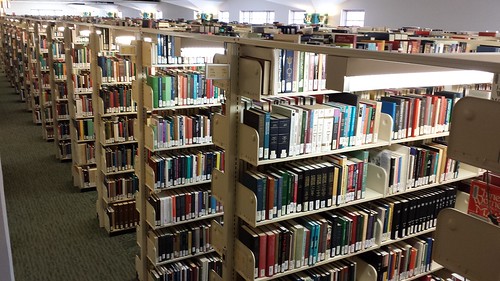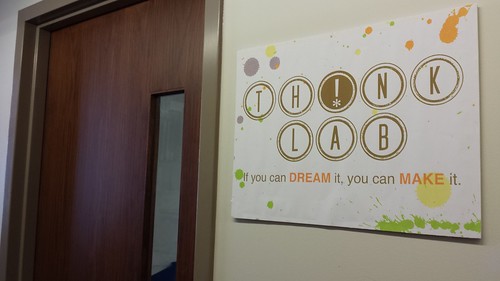
Here at UMW we have an on-going weeding project. Weeding means deselecting books from the collection. The Simpson Library (the building that the school’s library moved in to in the mid-80s from a much smaller building) has never undergone a major weeding project in its life. Sure, throughout the years books have been discarded here and there, but it appears a thorough examination of the collection has not occurred. The project at Mary Washington started in 2011 and we are still chugging along here in 2013 (with a lot more to go).
I was hired at the end of June this year as the Collection Maintenance Supervisor and I’ve learned a lot about all the pieces that make the library run. When I was told about the Library’s weeding project I was initially hesitant. I had many questions and concerns, so I started reading up on weeding. The more I read the better I understood the reason and methodologies of weeding a collection. So, why do we weed?
Libraries are like shrubberies. No really, a library is like a living organism. Not only do you need water and fertilize it, but you also have to prune it back too. A collection is at its best when it gets both forms of attention. Many studies have shown that a weeded collection actually circulates better! It seems counter-intuitive, how does having less books on the shelves equal more circulation? For starters, with less books to sort through the ones that people are really looking for are easier to find. A bit of human psychology plays in to this too. Shelves that aren’t packed too tightly and have books that are in good condition attract attention. People, for the most part, don’t pick up a book if it is in poor condition and the vast majority of books that are selected for weeding here at Simpson are older books that tend to be in poor condition.

How do we decide? Most literature on weeding suggests the best way to flag books for weeding is to look at the circulation count on the book. This is the most objective way that a library with a large collection can begin to tackle a weeding project. So, we look at the different circulation counts and the date the book was added to our collection. Depending on the subject area we are looking at we have slightly different criteria. For example, technology books should be weeded more aggressively (and regularly) because of the rapidly changing nature of technology. So, for that section we might have a shorter cut-off date than say for american literature. For most sections we have a cut-off date of 1998 for circulation. On our weeding slip it says, “This book has not circulated since 1998, or for its entire shelf life”. I will say that even with a cut-off date of 1998 the vast majority of the books we have been flagging are books that have never circulated or have extremely low circulation. There are a few more nuances about our selection of books for weeding, but that is how we start working our way through a section. After a section has been flagged we invite the faculty that cover the content area to come evaluate our choices. This is a critical step and without it our weeding project is blind in many ways. Faculty, the content experts, can tell us if something needs to stay. Maybe it is a superior translation of a work or it is an important part of a canon. One of the fun things for me, being down in the trenches on this project, is seeing the reasons faculty give for why a book should be saved: “Last nobel prize winner from his country”, “One of the few female poets. Mostly male poets on the shelves”. I hope that faculty, after spending time in the stacks, see not only what we have to offer, but make future suggestions about what we could add to better support their classes and their department’s mission.
But what if? There is an understandable fear that the Library will get rid of something that someone might need or something rare or valuable. This is certainly a possibility, but odds are the vast majority of what we recycle consists of unusable and out-dated books, which, is why they probably haven’t circulated. It is not a goal of the Simpson Library to be a major archival library. We don’t have the space or the funds to be that. At a small school like this we do our best to support current needs and for what we don’t have in house we have an amazing Inter-Library Loan program. Studies of weeded libraries show that there end up being very few requests on the books that were weeded. If something does come back in to demand in the future we can add it back to the collection. Ask yourself, is the small possibility we get rid of a book that is needed outweigh the gains we get from weeding the collection?

What is gained? As I’ve mentioned earlier in this post one of the gains of weeding a collection is increased circulation. I’d love to see our collection circulate more. As I commented in Betsy Lewis’s post, 73% of the books we are weeding from the PQ section have never circulated. Thousands of books that have never circulated, their stories unread, I think that is the bigger tragedy. By weeding our collection we create space on the shelves for more up to date content and we are able to grow content areas that support the shifts and changes in Mary Washington’s needs. We have a fairly new Women and Gender studies major and even newer Digital Studies minor. I think it is more important to support these areas than to hold on to some unused books because of a nostalgia for the printed text. Shelf space is a precious commodity in the library and by weeding we make the best use of that space. Freeing up space in the library means we can also think about doing something creative with the extra room. The Think Lab, which is housed in the Simpson Library, is a brilliant example of what freeing up space can do.
A few more things. I hope this post gives a glimpse in to what weeding is and why we do it. I encourage faculty to get familiar with what the library has to offer and to encourage student to use it too. We have wonderful reference librarians that know a thing or two about what the library has to offer (hint: it is not just books!). Honestly, most students don’t check-out books from the library unless they have a reason to and usually that reason is a class assignment. In an ideal world students would check out all kinds of books without prompting, but that is not the reality we live in. I much rather have to discard a book because it is so well used we have to replace it than have to discard a book because it has been neglected on our shelves for decades. If you care about saving books, you have to use them, that is the reality.
